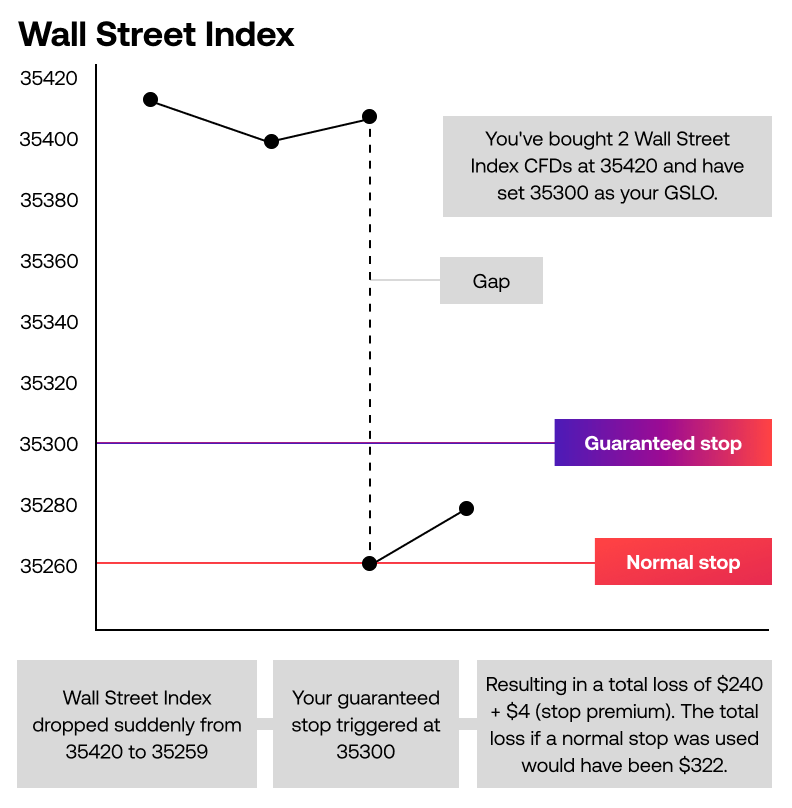Key features of GSLOs
GSLOs reduce your risk by protecting your funds from slippage or gapping caused by unexpected market movements.
|
Always close Your trade is guaranteed to close at your chosen price, regardless of market volatility. |
Free to place Setting GSLOs costs nothing – you’ll only be charged a small premium if the GSLO level is reached. |
Lower margin Trading with a guaranteed stop in place means you’ll be able to trade with lower margin. |
|
Amendments You can amend your guaranteed stop during market hours without incurring additional fees. |
Plan your trades Order levels must be placed at a minimum distance from the current quoted price. |
Availability Offered on more than 6,000 markets, GSLOs provide a cost-effective method of managing your risk. |
What are the costs involved?
Stop premium
If your trade reaches the guaranteed stop level and the GSLO is triggered, you’ll be charged a small premium to cover the guaranteed closeout. This is known as the ‘stop premium’ and varies by market. The stop premium is calculated as:
Trade Size x Stop Premium
Trade Size is the size of the position (expressed as the no. of contracts or stake size) x the value of each contract (expressed per point of movement)
For example, if you bought 2 Wall Street CFDs (where the stop premium is 1.8x quantity of CFDs/stake) and placed a GSLO, then your stop premium would be 2 x 1.8 = $3.60. You would only be charged this amount if your stop was triggered. You can see the stop premiums on our most popular markets below.
Margin requirement
GSLOs enable you to trade with a lower margin requirement than you would with a normal position, as you determine your maximum risk when setting your trade size and GSLO level.
When trading using GSLOs, margin is calculated as follows:
Trade Size x Stop Distance x 1.1
Stop distance is the distance between the opening price and the stop price; the additional 1.1 is a regulatory requirement
For example, if you bought 2 Wall Street CFDs at an opening price of 33,620 and set a GSLO at 33,500, then your stop distance would be 33,620 – 33,500 = 120. The total margin requirement for placing the trade would be 2 x 120 x 1.1 = $264.
Popular markets
Available across thousands of global markets, see GSLO premiums on our most heavily traded markets below.
| Indices | Premiums (charged upon trigger) |
|---|---|
| Germany 40 | 0.7 x CFDs or stake* |
| Australia 200 | 1 x CFDs or stake* |
| Wall Street | 1.8 x CFDs or stake* |
| UK 100 | 0.4 x CFDs or stake* |
| Equities | Premiums (charged upon trigger) |
|---|---|
| DBS Group Holdings | 0.25% of notional trade value |
| 0.25% of notional trade value | |
| Noble Group | 2.00% of notional trade value |
| Keppel REIT CFD | 0.25% of notional trade value |
| Commodities | Premiums (charged upon trigger) |
|---|---|
| Gold | 3 x CFDs or stake * |
| Silver | 2 x CFDs or stake * |
*Charged in base currency of the market and then converted to the base currency of the account.
Example of a GSLO trade
You believe the Wall Street market price is going to rise, so you buy 2 Wall Street CFDs with an opening price of 35,420.
You place a GSLO at 35,300, which means the maximum loss on the trade would be (35,420-35,300) x 2 = $240.
The stop premium for Wall Street is 1.8x the quantity of CFDs and would therefore be 1.8 x 2 = $3.60 if your GSLO was triggered.
The required margin is calculated as follows:
Trade Size x Stop Distance x 1.1
In this example, your margin requirement would be: 2 x 120 x 1.1= $264

As a result of high volatility, the price of the Wall Street Index moves against you and unexpectedly drops from 35,420 to 35,259.
Despite market gapping, your trade closes automatically at your specified GSLO price of 35,300.
Your total loss on the trade is therefore $240 (maximum risk) + $3.60(stop premium) = $243.60
If you had placed a standard stop loss order, then your position would have closed at the next available price (35,259) and resulted in a loss of $322.








